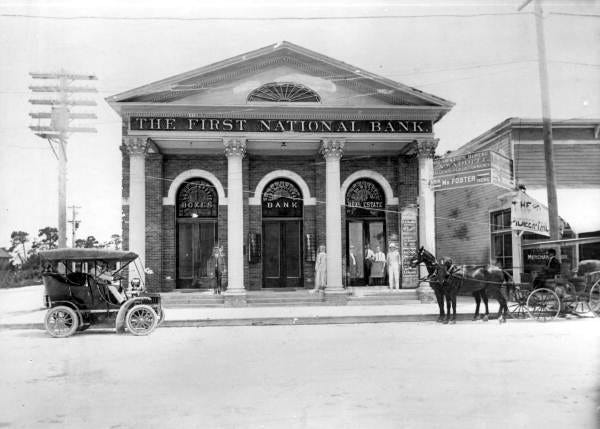Remembering Miami Pioneer Ed Romfh
Pioneer Edward C. Romfh was a member of Miami's first city commission, former mayor and most notably founder of the First National Bank of Miami. He was born on February 8, 1880, in Camden, Arkansas.
Those who took a chance on the fledgling city of Miami in the late 1890s understood that the municipality offered boundless opportunity but required versatility. From prior to incorporation until the start of the Twentieth Century, pioneers came to Miami seeking prospects to make a name for themselves. Edward C. Romfh was exactly the type of pioneer who applied his versatility and capitalized on the opportunity offered by a young city. In doing so, he is remembered with reverence in the lore of Miami’s early history.
Romfh served as bank president, city commissioner, mayor and the municipality’s calming influence during difficult times. While he had to ward off multiple runs on his bank, Romfh relied on his fiscally conservative business practices to survive financial meltdowns. During a period when others got caught up in what seemed like unfettered growth and prosperity, Romfh stuck to his principles. When he was mayor of the city during unprecedented expansion followed by disaster, Romfh’s restraint and cool demeanor helped provide leadership during trying times. He was truly a pioneer in both spirit and accomplishment.
Arrived in Miami in 1898
Edward C. Romfh was born on February 8, 1880 in Camden, Arkansas to George and Elvira Romfh. Shortly after his birth, the Romfhs moved from Arkansas to Altoona, Florida. The family would also live in Titusville and Atlanta, Georgia during Ed’s youth.
When he was ready to branch out on his own, Ed moved to Miami in 1898. After working odd jobs, he got a position with the Bank of Bay Biscayne as a bookkeeper. After gaining experience in banking, Romfh reflected on Miami’s growth and determined there was an opportunity for him to setup another bank in the Magic City.
Founded First National Bank in 1902
As a bookkeeper for the Bank of Bay Biscayne, Ed Romfh had experience in banking but did not have enough capital to start his own financial institution. However, what Ed lacked in capital, he compensated by having the ability to convince his business contacts with money to invest in his new venture. He convinced E.M. Brelsford, who became the president of the bank, W.H. Spitzer, who became the first vice-president, E.A. Waddell, who became the second vice-president, all to invest in the financial institution that was established as the First National Bank. Other investors in the institution included William H. Graham, William Burdine, and James E. Lummus. Romfh later recalled starting the bank with what he fondly referred to as $50,000 of borrowed money. Given his status as a founder, Romfh became a board member, but his first title with the bank he founded was “cashier”.
First National Bank was officially perfected on June 10, 1902 and opened for business on
December 1 of the same year. The bank collected $52,820 in deposits just in its first day. The institution constructed a modest one-story bank building at the northeast corner of Avenue C and Twelfth Street, or NE First Avenue and Flagler Street by today’s address scheme. It was completed by the time the bank was ready to open for business in December.
By 1910, Ed Romfh was promoted to bank president, a role he would hold onto until his retirement in 1946. By February of 1921, the bank had grown tremendously with deposits of more than $6.5 million. The growth of the bank necessitated the need for a larger building to conduct business, which led to the erection of a modern ten-story edifice on the same site as the original building. The building was completed and opened on November 14, 1922. It still stands today on the same corner as the First Flagler Condominium building.
Keep reading with a 7-day free trial
Subscribe to Miami History to keep reading this post and get 7 days of free access to the full post archives.







